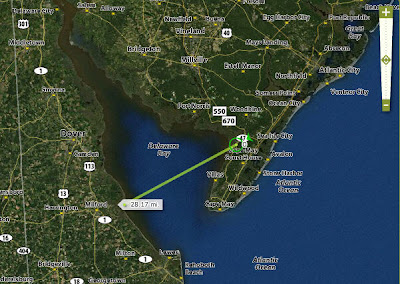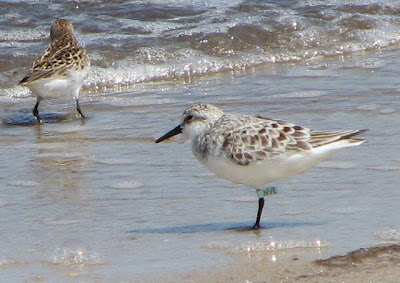It all started about three months ago on our trip to Chincoteague, VA. It was late May, good timing for shorebird migration, so we stopped in a few places on Delaware Bay to look for Red Knots and/or Horseshoe Crabs among other mid-Atlantic goodies. At one of those stops we found a beach littered with Sanderlings and a smattering of Dunlin. Several came within a few yards of us as the Sanderlings alternated chasing the surf and being chased by the surf. That's when we noticed one bird was tagged.
 Typical Sanderling behavior: constant motion, running with the
Typical Sanderling behavior: constant motion, running with thewaves. Click on the image for a larger view and you can read the tag.
It also turned out this Sanderling was missing a leg. How that happened we'll likely never know, but by recording the band style, color, and markings we were able to find out what happened to its remaining leg: who affixed the tag, where and when was it done?
Turns out this handsome fellow, or pretty lady, was banded May 19th, 2006 in Goshen, New Jersey. At banding it wasn't possible to determine with any precision how old the bird is, the official record shows it was "hatched in 2004 or earlier." Sex is "unknown," and as far as they listed, the only encounter data was when we crossed paths on May 24th, 2008 at Slaughter Beach in Delaware.
 The tagged Sanderling was resighted about 28 miles from
The tagged Sanderling was resighted about 28 miles fromwhere it was banded two years ago. We're sure it has seen
much more travel than that over the past two years.
With Bob Dylan's "If You See Her, Say Hello" as background music my mind moves from where it was banded to where it's been, and where is it going? Knowing who put the tag there answered some questions but opened many more. What has this bird been doing for the past two years? Where does it call home, that beach where it spends the winter? Did we both just arrive at Slaughter Beach that day, both to depart shortly thereafter? It's possible this bird winters along the mid-Atlantic coast, but consider this: the Sanderling's wintering range extends from southern Maine south to southern Argentina, or, said another way, it "spans some 100° latitude, encompassing most temperate and tropical beaches in the Americas" (from the Birds of North America Online). This bird might be loafing on this beach, the same beach it spends each winter, or it might have flown up to 6,500 miles just to reach Delaware Bay.
Where has it summered? Sanderlings breed in the high Arctic, and I assume this one, one-legged and all, still reacts to the overwhelming urge to migrate and to breed. Its short breeding season is probably spent some 2,500 miles from our Delaware rendezvous, high in Nunavut, Canada.
Finally, how does it move between those two sites? Does it take the same path year after year, stopping in the same locations? In a sense, we do the same thing. We travel the same route to coastal Virginia each summer, following the same network of interstates and local roads, often stopping at the same restaurants and rest areas to recuperate. I suspect stopping in Goshen, NJ one year and Slaughter Beach, DE the next is akin to us stopping at a diner in Clark's Summit, PA one year and a different restaurant in neighboring Scranton the next.
That similarity aside my USGS-CWS achievement seems a little less noteworthy while this individual's accomplishment is awesome; awesome in the old-fashioned, Biblical sense, as well as the Jeff Spicoli surfer-sense (get me near a beach and my mind always wanders to "Fast Times").
So, with due deference, I yield my certificate to this Sanderling. By the time I'm writing this it's already finished this year's breeding attempt and is winging its way south to whichever beach, temperate or tropical, it calls home. I wishing it safe travels, hopefully we can cross paths next spring again. Oh, and if you see her, please say hello - and report your sighting!
- For more about Sanderlings check out All About Birds Bird Guide or the BNA Online (subscription)
- Listen to "If You See Her, Say Hello" (Bob Dylan).
- Watch a Jeff Spicoli montage on YouTube.
- Report a banded bird with the North American Bird Banding Program (Bird Banding Laboratory)





5 comments:
A link to a past, present and future! great post and wonderful photos!
How did it run properly, like Sanderlings do, if it only had one leg?
deejbrown - I didn't even think of the link across time, glad you pointed that out to me. Maybe it was rolling around in the subconscious while I wrote. I like the idea of birds being able to link elements in time and space, and I love the fact I'm always discovering new aspects to avian life, whether directly or indirectly, like on other people's blogs. Oooh, "OPBs," I think I'm going to have to use that . . . you down with OPB? Yeah, you know me!
Which brings me to n8: man, I knew someone was going to ask that. I almost addressed it in the post but thought people wouldn't really think about it - I was writing mostly about wing-travel, not running!
Anyway, I have to confess I don't know. I couldn't even tell you the full extent that bird was "with" us as we stood there, there seemed to be a regular turnover of the birds in our immediate area. We did watch it for what felt like several minutes, but could've been less than a minute. It never notably hopped while I had the camera or bins trained on it, but it did scurry along with the other birds. Even when lost in a group engaged in surf-avoiding running I never noticed an aberrant bird hopping, flitting, or other-moving away/towards the water.
There's always the possibility the other leg was present, tucked high in the belly/vent feathers and unnoticed, but I don't think so.
I know that "I dunno" is high on the non-satisfactory answers, but the best I can do with this bird.
I suppose we could run an experiment if we could get some funding . . . .
:-)
Thanks for dropping by!
-Mike
I just returned from Rehobeth Beach, Del on 11/9/08 and saw many 1 legged sanderlings. I thought they actually only had one leg, as they not only stood, but hopped on one leg while their two legged friends ran. I just searched Google and found someone that stated they will stand on one leg and if disturbed, will hop away on one leg. I am relieved - I thought I had come across either a group of mutant sanderlings, or that they all suffered some sort of similar accident or attack. I do have video of them hopping away from the waves. It was a glorious day on a completely deserted beach!
Val from MD
I recently took photos of a sanderling with a tag as well in Barbados (Different code though) and I sent the info off to Canadian Wildlife who have promised to send Certificate of appreciation and bird history.
Post a Comment